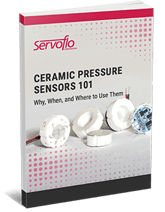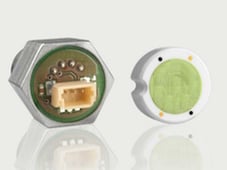Industry professionals employ pressure sensors in a variety of applications, ranging from aerospace to oil and gas to utilities. In many cases, they are subjected to harsh operating and environmental conditions, such as high pressures, corrosive compounds, and temperature extremes. For use in these circumstances, ceramic pressure sensors are a suitable option.
Pressure sensors are often employed to handle extreme conditions such as high pressures, corrosive atmospheres, and high temperature processes. Ceramic pressure sensors are an ideal alternative to conventional oil-filled pressure sensors under such circumstances.
Because of their unique construction and ceramic’s chemically inert nature, ceramic pressure sensors can withstand harsh atmospheric conditions without sacrificing performance. Robust, reliable, and washable, they are a durable and cost-effective solution to a variety of demanding applications.
The following blog post provides an overview of ceramic pressure sensors, outlining the benefits, types available, and applications.
Benefits of Ceramic Pressure Sensors
Ceramic pressure sensors offer several benefits, including:
- Greater strength and durability. Compared to their stainless steel counterparts, sensing diaphragms made of ceramic are 10x stronger. This quality results in greater durability and longevity. Ceramic’s superior resistance to abrasion further enhances these characteristics.
- Lower cost. Ceramic diaphragms are less expensive to manufacture than stainless steel ones. This quality, coupled with longer service life, can result in significantly lower equipment costs.
- Better corrosion and chemical resistance. Ceramic is chemically inert and corrosion resistant, making it highly compatible with most process materials.
- Smaller environmental risk. Ceramic sensors do not contain oil, reducing their risk of negatively impacting the surrounding environment due to fluid leaks.
- Higher temperature and pressure operating capacities. Ceramic is capable of withstanding greater pressures and temperatures than stainless steel. It also displays a broader range of sensitivity, with the ability to simultaneously measure low pressure while withstanding high overpressure.
The above qualities, among others, make ceramic pressure sensors well-suited for applications with harsh environments. Even when exposed to high pressures, extreme temperatures, corrosive compounds, or high levels of shock and vibration, they provide consistent and reliable performance.
Ceramic pressure sensors have many advantages over traditional stainless steel counterparts. Perhaps most importantly, they are significantly stronger than oil-filled diaphragms. Similarly, they can withstand high operating temperatures and pressures without losing sensitivity at low pressure values. They tolerate relatively high over pressures as well.
Since ceramic sensors do not rely on oil, the diaphragm can be thicker, and it does not carry the risk of a leak that could compromise an entire batch of sensors. Because they are sturdier, ceramic pressure sensors will not deviate from their calibrated setting even after multiple operating cycles, thus minimizing the risk of sensor drift. All these features make ceramic pressure sensors ideal for a large number of industrial applications, particularly if accuracy, dynamic range, and corrosion resistance are critical requirements.
Types of Ceramic Pressure Sensors
Ceramic pressure sensors are available in a wide range of designs, each suited for use in particular applications. Some of the most common ceramic pressure sensor variations include:
Flush Mount vs. Monolithic Sensors
The key difference between flush mount and monolithic ceramic pressure sensors lies in the surface design. While flush mount sensors provide a flat surface for exposure to the pressure media, monolithic sensors feature an indentation in the exposed side of the sensors. As flush mount sensors maintain a fixed reference, they are generally used for applications that require absolute or sealed gauge sensing.
Piezoresistive vs. Capacitive Sensors
Ceramic pressure sensors employ either piezoresistive or capacitive means to measure pressure. Piezoresistive sensors measure the changes in electrical current in direct correlation to changes in pressure on the diaphragm. Capacitive sensors measure pressure displacement by analyzing the difference in electrical frequency between two sensors. The latter type is preferable for applications that require the measurement of low-pressure values under high overpressure conditions.
Amplified vs. Unamplified Sensors
Pressure sensors come with several amplification options—including ratiometric, non-radiometric, current loop, and I2C—each of which can be calibrated as needed. For users who wish to perform their own amplification and calibration, unamplified ceramic sensors are also available.
Ratiometric vs. Non-Ratiometric Sensors
Ratiometric sensors take into account the power supply when converting sensor output, allowing for more accurate measurement without the interference of power supply variation. Non-ratiometric sensors are used when the measurements are against an absolute reference and not affected by fluctuation of the power source.
When to Use Ceramic Pressure Sensors
 Ceramic pressure sensors are suited to a wide variety of industries. In the automotive industry, for example, they are often used to measure oil levels. Within the transportation industry, they are used to maintain hydraulic systems (which benefit from greater water resistance) and control emissions (where greater resistance to heat and corrosion may be necessary). They are also used to measure the flow rate of the working fluid in water reservoirs, wastewater treatment plants, and other chemical processing plants.
Ceramic pressure sensors are suited to a wide variety of industries. In the automotive industry, for example, they are often used to measure oil levels. Within the transportation industry, they are used to maintain hydraulic systems (which benefit from greater water resistance) and control emissions (where greater resistance to heat and corrosion may be necessary). They are also used to measure the flow rate of the working fluid in water reservoirs, wastewater treatment plants, and other chemical processing plants.
Due to their superior resistance to corrosion, high pressures, and extreme temperatures, ceramic pressure sensors find use in a variety of industrial applications with harsh environmental and operating conditions. Typical industries that employ these devices include:
- Automotive instrumentation
- Chemical
- Food and beverage
- Heavy manufacturing
- HVAC
- Oil and gas
- Water and wastewater treatment
The high strength of ceramic sensors makes them ideally suited for applications that feature a large number of pressure cycles. Because of ceramic’s chemically non-reactive nature, they can be used in HVAC systems to measure refrigerant levels and for flow measurement in the oil and gas industry. They are also inert enough for use in the food and beverage industry to monitor ingredient flow.
High-Quality Ceramic Pressure Sensors From Servoflo
For decades, Servoflo has served industries with quality pressure sensor support, optimization, and system design services. With customers from every major industry, ranging from aerospace to waste management, we have the knowledge and experience to provide ceramic pressure sensors that suit any requirement.
For the last 30 years, Servoflo has offered technical support, product optimization, and system design services to users of pressure sensors in every major industry. Trusted by companies of every size, our pressure sensors can handle difficult applications with accuracy and efficiency.

In particular, our ceramic sensors offer unmatched quality and reliability in industries ranging from aerospace to waste management. Regardless of your demands, Servoflo can help you meet any requirement.
If you’d like to learn more about Servoflo’s ceramic pressure sensors or discover how they can improve your business, download our “Ceramic Pressure Sensors 101: Why, When, and Where to Use Them” eBook today.


